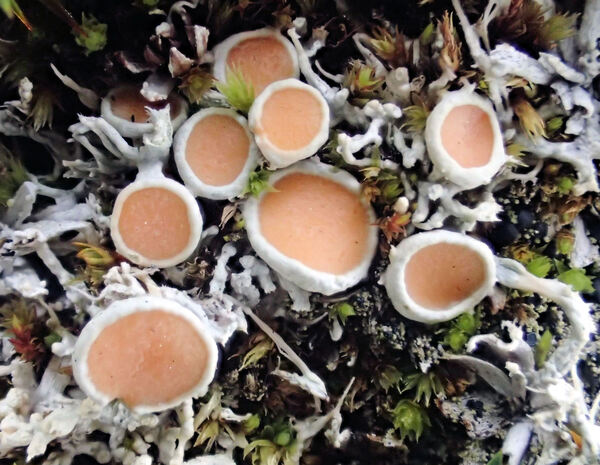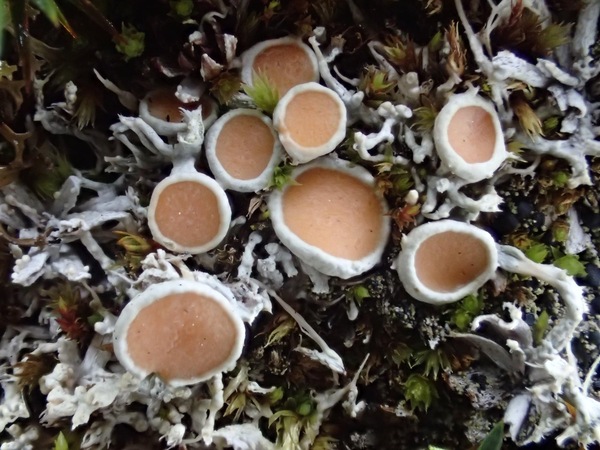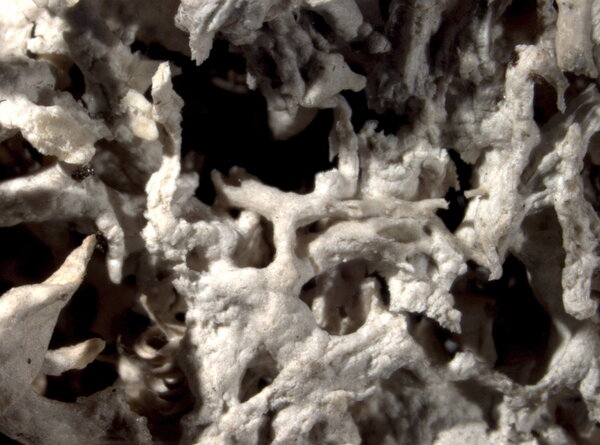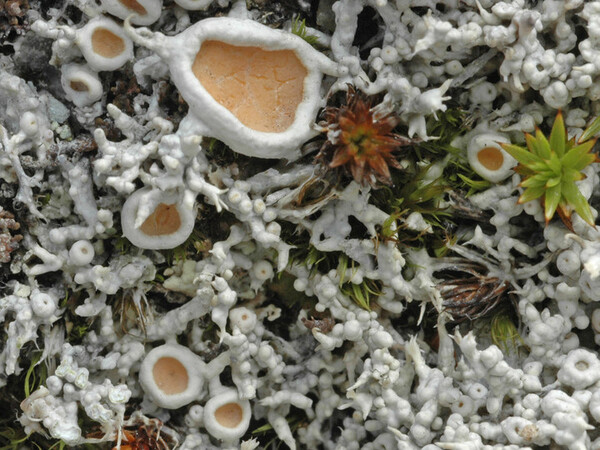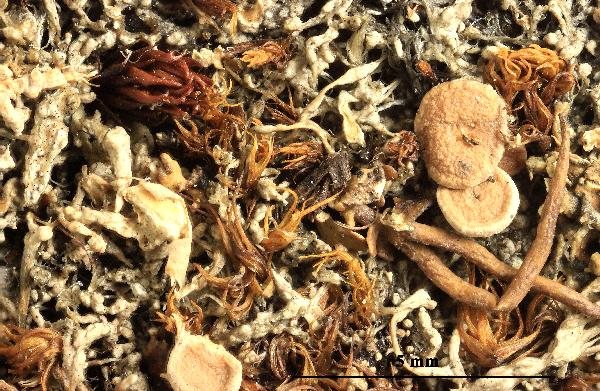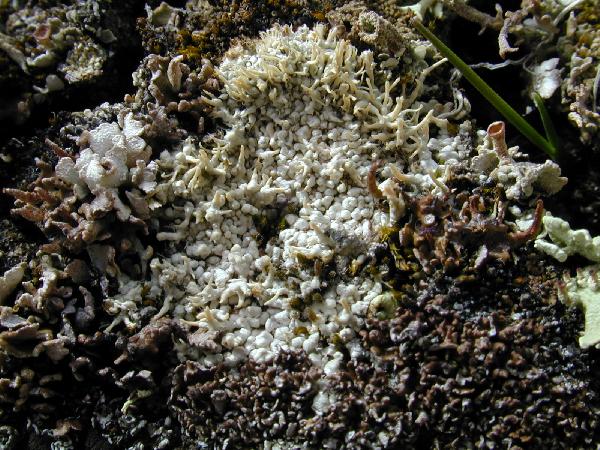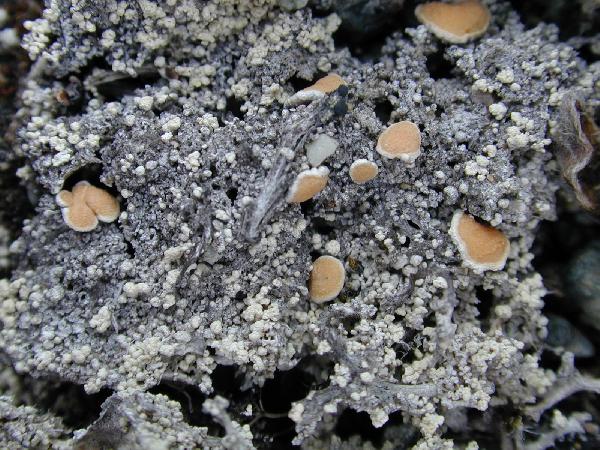Ochrolechia frigida (Sw.) Lynge
Rep. Sc. Res. Norw. Exp. Novaya Zemlya 1921, 43: 182, 1928. Basionym: Lichen frigidus Sw. - Meth. Muscor.: 36, 1781.
Synonyms: Ochrolechia elisabethae-kolae Verseghy; Ochrolechia gonatodes (Ach.) Räsänen; Ochrolechia groenlandica Verseghy; Ochrolechia lapuënsis (Vain.) Räsänen; Ochrolechia pterulina (Nyl.) G.E. Howard; Ochrolechia subtartarea (Nyl.) A. Massal.?; Ochrolechia tartarea var. thelephoroides (Th. Fr.) Arnold
Distribution: N - TAA (Nascimbene & al. 2022), Lomb (Ravera & al. 2022b), Piem (Isocrono & al. 2004), VA.
Description: Thallus crustose, episubstratic, whitish to whitish grey or pale yellowish brown, extremely variable, very thin to very thick, with or without long spine-like outgrowths, continuous and membrane-like to areolate-verrucose, the areoles sometimes tending to become subfruticose, esorediate or sorediate; soredia farinose or granular, forming more or less discrete soralia on continuous thalli, or developing on the top of areoles, rarely at the base of spines, or areoles completely dissolving into soredia, and forming a sorediate crust. Apothecia frequent, lecanorine, up to 4 mm across, with a concave to flat, usually epruinose, often radially fissured, pale brown to reddish brown disc, a usually smooth or sorediate thalline margin and often a prominent excipular ring. Thalline exciple corticate, the cortex c. 50-75 μm wide; epithecium brownish, C+ red; hymenium colourless, c. 170-250(-300) μm high; paraphyses thin, slender, densely branched and anastomosing; hypothecium yellowish. Asci (4-)6-8(-12)-spored, with thick, amyloid walls, without recognizable apical structures, Pertusaria-like. Ascospores 1-celled, hyaline, variable in size and shape, from ellipsoid to pyriform, rarely subglobose, 20-50(-67) x (6-)12-30(-42) μm. Photobiont chlorococcoid. Spot tests: cortex and apothecial disc K-, C+ red, KC+ red, P-; medulla C-, KC-. Chemistry: gyrophoric acid (major) and lecanoric acid (trace to minor), sometimes with fatty acids of the murolic acid complex, or with traces of additional unidentified substances.Note: an arctic-alpine, circumpolar species found on mosses, plant debris and soil in the Alps, where it reaches the nival belt. All Italian records need confirmation (see Nimis 1993: 455).
Growth form: Crustose
Substrata: soil, terricolous mosses, and plant debris
Photobiont: green algae other than Trentepohlia
Reproductive strategy: mainly sexual
Commonnes-rarity: (info)
Alpine belt: extremely rare
Subalpine belt: absent
Oromediterranean belt: absent
Montane belt: absent
Submediterranean belt: absent
Padanian area: absent
Humid submediterranean belt: absent
Humid mediterranean belt: absent
Dry mediterranean belt: absent
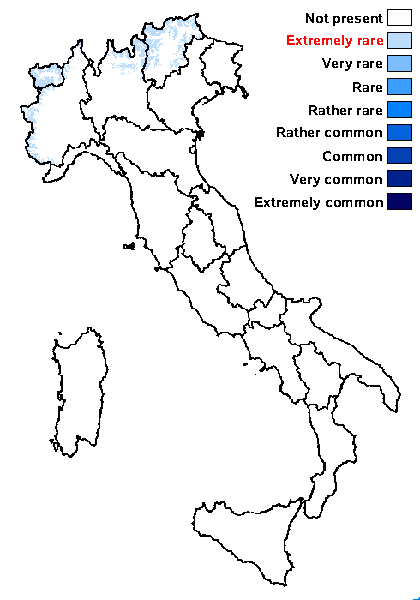
Predictive model
Herbarium samples
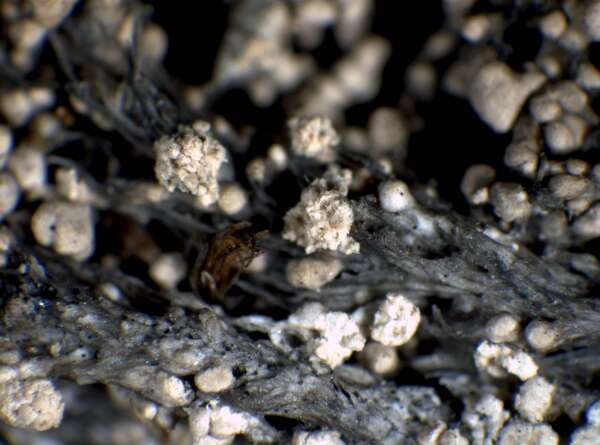

P.L. Nimis; Owner: Department of Life Sciences, University of Trieste
Herbarium: TSB (9264)
2001/11/27
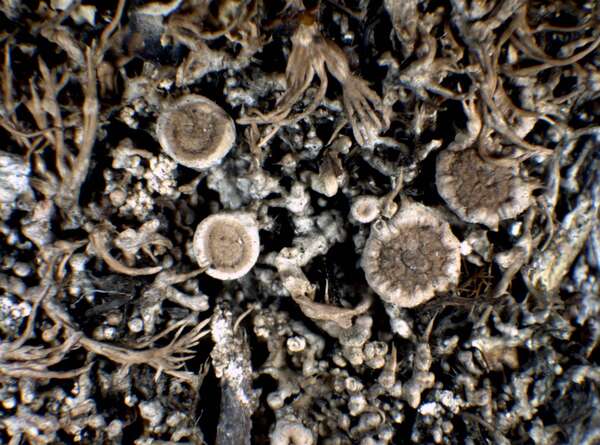

P.L. Nimis; Owner: Department of Life Sciences, University of Trieste
Herbarium: TSB (9264)
2001/11/27


Felix Schumm - CC BY 4.0
[2031], Finnland, Nylandia, Borga landskommun, Kullo, Fagelmossen,
treeless fen. Leg. Pentti Alanko, 19.10.1969 (Nr. 14,503), det. P. Alanko.
Ex Plantae Fennicae.


Felix Schumm - CC BY 4.0
[2031], Finnland, Nylandia, Borga landskommun, Kullo, Fagelmossen,
treeless fen. Leg. Pentti Alanko, 19.10.1969 (Nr. 14,503), det. P. Alanko.
Ex Plantae Fennicae.
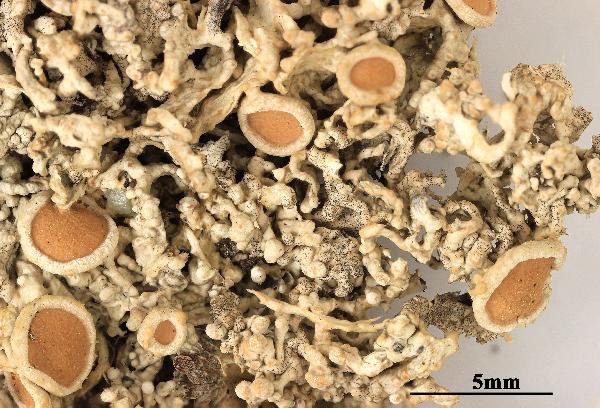

Felix Schumm - CC BY 4.0
[12003], Schweden: Lappland, District of Abisco, northern slope of
Vassitåkka southeast of Riksgränsen, on protected moss-covered faces
of siliceous rocks and remnants of dwarf shrubs on peaty mounds, here
and there accompanied by Ochrolechia androgyna, 900-1100 m. Leg.
G. Follmann 09.1992, det. G. Follmann, 09.1992. EX G. FOLLMANN &
B. WERNER:LICHENES EXSICCATI AB INSTITUTO BOTANICO UNIVERSITATIS
COLONIENHSIS EDITI NR. 553.
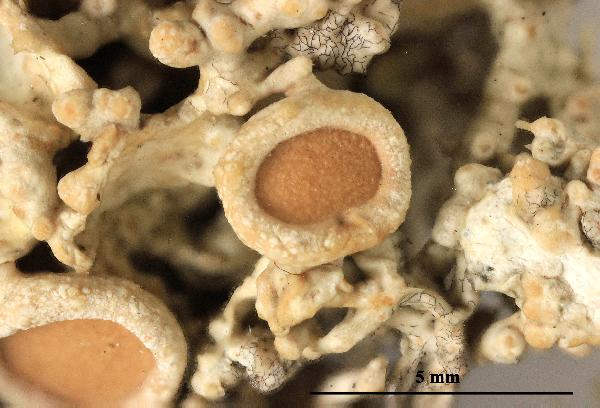

Felix Schumm - CC BY 4.0
[12003], Schweden: Lappland, District of Abisco, northern slope of
Vassitåkka southeast of Riksgränsen, on protected moss-covered faces
of siliceous rocks and remnants of dwarf shrubs on peaty mounds, here
and there accompanied by Ochrolechia androgyna, 900-1100 m. Leg.
G. Follmann 09.1992, det. G. Follmann, 09.1992. EX G. FOLLMANN &
B. WERNER:LICHENES EXSICCATI AB INSTITUTO BOTANICO UNIVERSITATIS
COLONIENHSIS EDITI NR. 553.
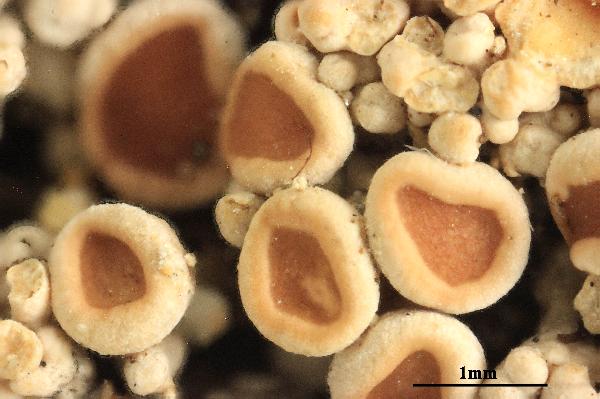

Felix Schumm - CC BY 4.0
[KU675], Svalbard. Spitzbergen. Ca. 3 km NW of Ny-Ålesund. Kongsfjorden.
On mosses, 0-50 m. Leg. H. Kashiwadani (no. 22910),
20.07.1985, det, H. Kashiwadani. EX S. KUROKAWA AND H. KASHIWADANI:
LICHENES RARIORES ET CRITICI WXSICCATI NR. 675.
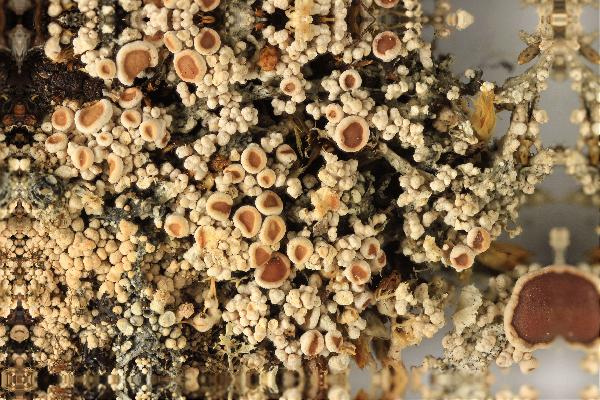

Felix Schumm - CC BY 4.0
[KU675], Svalbard. Spitzbergen. Ca. 3 km NW of Ny-Ålesund. Kongsfjorden.
On mosses, 0-50 m. Leg. H. Kashiwadani (no. 22910),
20.07.1985, det, H. Kashiwadani. EX S. KUROKAWA AND H. KASHIWADANI:
LICHENES RARIORES ET CRITICI WXSICCATI NR. 675.
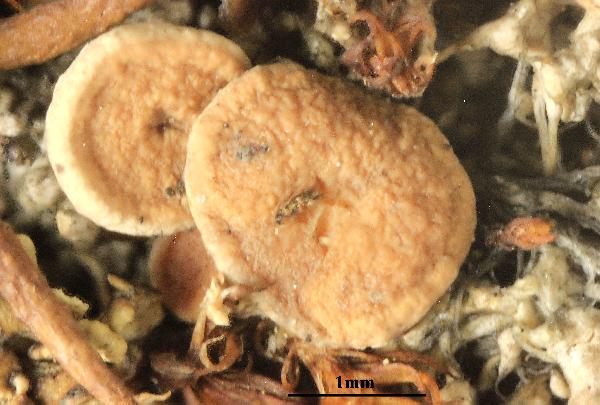

Felix Schumm - CC BY 4.0
[VZ1750], Norvegia. Hordaland. Granvin, loco Smøreggen. Leg. et det.
J. J. Havaas, 04.09.1940. - Gyrophoric acid and lecanoric acid by TLC,
anal. A. Johnson and C. F. Culberson (no. 2598). EX A. V ZDA: LICHENES
SELECTI EXSICCATI NR. 1750.
Growth form: Crustose
Substrata: soil, terricolous mosses, and plant debris
Photobiont: green algae other than Trentepohlia
Reproductive strategy: mainly sexual
Commonnes-rarity: (info)
Alpine belt: extremely rare
Subalpine belt: absent
Oromediterranean belt: absent
Montane belt: absent
Submediterranean belt: absent
Padanian area: absent
Humid submediterranean belt: absent
Humid mediterranean belt: absent
Dry mediterranean belt: absent

Predictive model
| Herbarium samples |


P.L. Nimis; Owner: Department of Life Sciences, University of Trieste
Herbarium: TSB (9264)
2001/11/27


P.L. Nimis; Owner: Department of Life Sciences, University of Trieste
Herbarium: TSB (9264)
2001/11/27


Felix Schumm - CC BY 4.0
[2031], Finnland, Nylandia, Borga landskommun, Kullo, Fagelmossen, treeless fen. Leg. Pentti Alanko, 19.10.1969 (Nr. 14,503), det. P. Alanko. Ex Plantae Fennicae.


Felix Schumm - CC BY 4.0
[2031], Finnland, Nylandia, Borga landskommun, Kullo, Fagelmossen, treeless fen. Leg. Pentti Alanko, 19.10.1969 (Nr. 14,503), det. P. Alanko. Ex Plantae Fennicae.


Felix Schumm - CC BY 4.0
[12003], Schweden: Lappland, District of Abisco, northern slope of Vassitåkka southeast of Riksgränsen, on protected moss-covered faces of siliceous rocks and remnants of dwarf shrubs on peaty mounds, here and there accompanied by Ochrolechia androgyna, 900-1100 m. Leg. G. Follmann 09.1992, det. G. Follmann, 09.1992. EX G. FOLLMANN & B. WERNER:LICHENES EXSICCATI AB INSTITUTO BOTANICO UNIVERSITATIS COLONIENHSIS EDITI NR. 553.


Felix Schumm - CC BY 4.0
[12003], Schweden: Lappland, District of Abisco, northern slope of Vassitåkka southeast of Riksgränsen, on protected moss-covered faces of siliceous rocks and remnants of dwarf shrubs on peaty mounds, here and there accompanied by Ochrolechia androgyna, 900-1100 m. Leg. G. Follmann 09.1992, det. G. Follmann, 09.1992. EX G. FOLLMANN & B. WERNER:LICHENES EXSICCATI AB INSTITUTO BOTANICO UNIVERSITATIS COLONIENHSIS EDITI NR. 553.


Felix Schumm - CC BY 4.0
[KU675], Svalbard. Spitzbergen. Ca. 3 km NW of Ny-Ålesund. Kongsfjorden. On mosses, 0-50 m. Leg. H. Kashiwadani (no. 22910), 20.07.1985, det, H. Kashiwadani. EX S. KUROKAWA AND H. KASHIWADANI: LICHENES RARIORES ET CRITICI WXSICCATI NR. 675.


Felix Schumm - CC BY 4.0
[KU675], Svalbard. Spitzbergen. Ca. 3 km NW of Ny-Ålesund. Kongsfjorden. On mosses, 0-50 m. Leg. H. Kashiwadani (no. 22910), 20.07.1985, det, H. Kashiwadani. EX S. KUROKAWA AND H. KASHIWADANI: LICHENES RARIORES ET CRITICI WXSICCATI NR. 675.


 INDEX FUNGORUM
INDEX FUNGORUM
 GBIF
GBIF
 DOLICHENS
DOLICHENS
